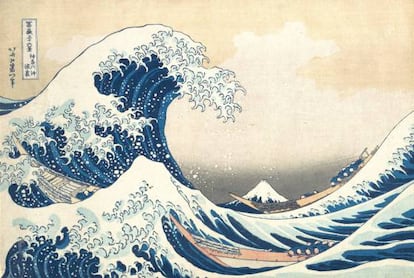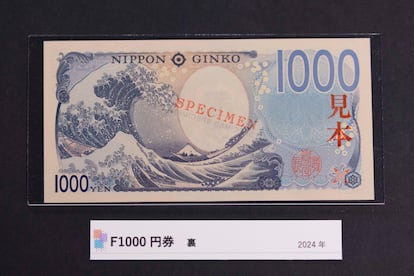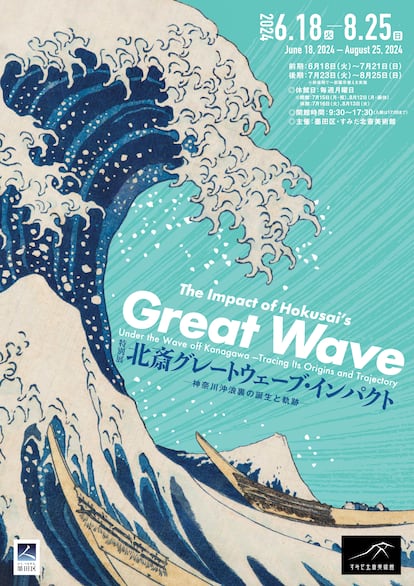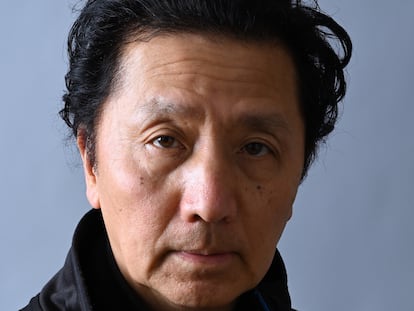‘The Great Wave off Kanagawa’: From a T-shirt design to illustrating Japan’s new banknotes
The most reproduced Japanese work of art in the world is still iconic after almost two centuries and is the subject of a new exhibition in Tokyo at the museum dedicated to its creator, Katsushika Hokusai

The most reproduced Japanese artwork in the world, The Great Wave off Kanagawa, is featured on the new 1,000 yen banknotes issued last month. Tokyo is also paying tribute to the work with a major exhibition at a museum dedicated to its creator, Katsushika Hokusai (1760-1849). The famous print is one of the works in the series Thirty-six Views of Mount Fuji, created between 1830 and 1833, when Hokusai was 70 years old. The work — originally titled Under the Wave off Kanagawa — shows Japan’s iconic mountain framed by a huge wave, with its claws of foam. Three boats manned by tiny figures, powerless in the current, are integrated into the composition with such skill that they often go unnoticed at first glance.
Its iconic simplicity and affordable price made the print a popular decorative design, with thousands of undated and unnumbered reproductions made. It was taken to Europe along with other Japanese works in the Ukiyo-e genre (pictures of the floating world), and acquired by artists such as Claude Monet and Claude Debussy: it is the inspiration for the composer’s orchestral composition The Sea.
It is considered one of the central works of Japonisme, the 19th century aesthetic movement driven by European creators’ fascination towards an aesthetic rich in asymmetry, vibrant colors, expressive lines and large empty spaces.
Today, The Great Wave is popularly used by Western designers seeking to express a sense of Japan, and it can be found on book covers, posters, T-shirts and baseball caps. The work — which is part of prestigious collections of the British Museum, the Metropolitan Museum of Art in New York and the National Library of France — has been compared to paintings that have become symbols of national cultures, such as Leonardo da Vinci’s Mona Lisa.
“It is curious — and of course an honor — that the value of a popular print that hung in the homes of ordinary citizens is recognized and given the same status as original works commissioned by the nobility,” says Atsuko Okuda, curator of the exhibition The Impact of Hokusai’s ‘Great Wave’. Tracing Its Origin and Trajectory, open until August 25 at the Sumida Hokusai Museum in Tokyo.

The exhibition coincides with the launch of a new 1,000-yen banknote featuring The Great Wave. It is the second official tribute to the work: in 2020, it was chosen to grace the pages of the Japanese passport. But while it is considered a symbol of Japan, the image is a cultural hybrid that brings together European techniques, Chinese forms of representation and Japanese pictorial traditions. “The dynamics of the composition are dominated by the rules of Western perspective,” says Okuda, pointing to the low horizon line that places the viewer’s gaze at sea level, which gives prominence to the sky and makes Fuji appear smaller.
Hokusai lived towards the end of the Edo period (1603-1868), when a hereditary military dictatorship ruled Japan and the country isolated itself from the world after outlawing Christianity, considering it an outpost of Portuguese and Spanish expansion. Although external contact was limited to trade in products with the Dutch and Chinese, through an artificial island in the port of Nagasaki, the entry of Western scientific books was permitted from 1720, and technical concepts such as linear perspective were learned. Prussian blue also began to be imported. In addition to resisting fading, this pigment — which was invented at the beginning of the 18th century — was a perfect vehicle for expressing depth in landscapes such as The Great Wave.
Hokusai was also influenced by contemporary Chinese painters. Okuda names Shen Quan (1682-1760), an artist who lived in Nagasaki, who painted animals and plants in highly realistic compositions of almost baroque ornamental complexity. In a seascape, the Chinese master painted the foam of the waves in the shape of claws, a possible influence on Hokusai, who had been painting blunt waves curving inwards for decades. In response to the idea that The Great Wave documents a typhoon or tsunami, Okuda explains that the boats in the work are not in any danger, as they were ships propelled by eight oarsmen and used to quickly transport fresh fish to Edo (present-day Tokyo).

Many reproductions
Regarding the number of printed works in circulation, Okuda says many copies are of poor quality due to the wear and tear of the plates from which they were printed, or their poor state of conservation. The Sumida Hokusai Museum has three different copies, which are exhibited one at a time. The high quality of the prints is evident in the sharpness of the box containing the title of the work, the precision of the drawing and the clarity of the clouds. The highest price paid for a copy of The Great Wave was $2.7 million at the Christie’s auction house in New York in March 2024.
The West’s interest in Hokusai — and in Japanese art in general — is thought to have stemmed from the international exhibitions that took place in France in the 19th century. At the 1867 Paris exhibition, Japan was making itself known to the world after more than two centuries of isolation, and Hokusai’s work convinced the local intelligentsia that they were seeing a unique cultural phenomenon. For the 1889 World’s Fair, the painter Henri Rivière created his series Thirty-Six Views of the Eiffel Tower, a parody of the emblematic wrought iron structure portrayed from different corners of Paris.
Many European critics believe that Japanese art was instrumental in ending the dominance of French academicism and ushering in Impressionism and decorative styles focused on nature and craftsmanship, such as Art Nouveau and its respective national versions. Hokusai’s list of avowed admirers includes Vincent van Gogh, Edgar Degas, the poet Rainer Maria Rilke, and the 20th-century painters Roy Lichtenstein and Andy Warhol.
Hokusai, who was born in the neighborhood where the museum in his honor now stands, constantly faced economic hardship, and only asked to live to 90 years old so that he could become “a true artist.” In 2015, his legacy entered the vocabulary of the digital world, with an image of The Great Wave becoming an emoji.
Sign up for our weekly newsletter to get more English-language news coverage from EL PAÍS USA Edition
Tu suscripción se está usando en otro dispositivo
¿Quieres añadir otro usuario a tu suscripción?
Si continúas leyendo en este dispositivo, no se podrá leer en el otro.
FlechaTu suscripción se está usando en otro dispositivo y solo puedes acceder a EL PAÍS desde un dispositivo a la vez.
Si quieres compartir tu cuenta, cambia tu suscripción a la modalidad Premium, así podrás añadir otro usuario. Cada uno accederá con su propia cuenta de email, lo que os permitirá personalizar vuestra experiencia en EL PAÍS.
¿Tienes una suscripción de empresa? Accede aquí para contratar más cuentas.
En el caso de no saber quién está usando tu cuenta, te recomendamos cambiar tu contraseña aquí.
Si decides continuar compartiendo tu cuenta, este mensaje se mostrará en tu dispositivo y en el de la otra persona que está usando tu cuenta de forma indefinida, afectando a tu experiencia de lectura. Puedes consultar aquí los términos y condiciones de la suscripción digital.
More information
Archived In
Últimas noticias
Chris Martin, Taylor Swift, Elijah Wood and other famous wedding ‘crashers’
‘How does it feel to be a failure?’: Elizabeth Berkley’s journey from ‘Showgirls’ ridicule to vindication
The story of the Málaga virus: The code that haunted Google’s cybersecurity center director for 30 years
The impact of Ecuador’s mega-prison: A polluted river, cleared forests and military checkpoints
Most viewed
- Christian Louboutin: ‘Young people don’t want to be like their parents. And if their parents wear sneakers, they’re going to look for something else’
- The low-cost creative revolution: How technology is making art accessible to everyone
- Liset Menéndez de la Prida, neuroscientist: ‘It’s not normal to constantly seek pleasure; it’s important to be bored, to be calm’
- All the effects of gentrification in one corner of Mexico’s Colonia Roma
- December Social Security and SSI payments: Dates, double checks and the 2026 COLA increase











































